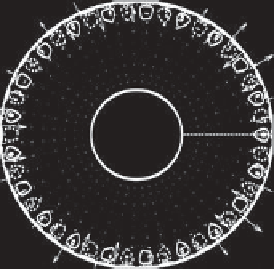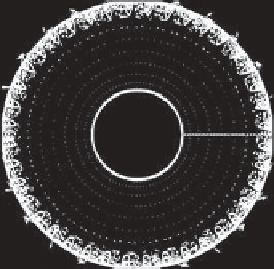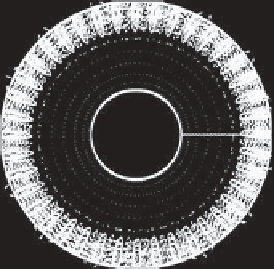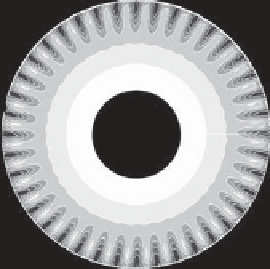Geoscience Reference
In-Depth Information
(c)
4
4
4
3
3
3
2
2
2
1
1
1
0
0
0
-1
-1
-1
-2
-2
-2
-3
-3
-3
-4
-4
-4
-4
-3
-2
-1
0
1
2
3
4
-4
-3
-2
-1
0
1
2
3
4
-4
-3
-2
-1
0
1
2
3
4
(d)
2.5
2.5
2
1. 5
1
0.5
0
-0.5
-1
-1.5
-2
-2.5
2.5
2
1. 5
1
0.5
0
-0.5
-1
-1.5
-2
-2.5
2
1. 5
1
0.5
0
-0.5
-1
-1.5
-2
-2.5
-2.5 -2 -1.5 -1 -0.5 0
0.5
1
1.5
2
2.5
-2.5 -2 -1.5 -1 -0.5 0
0.5
1
1.5
2
2.5
-2.5 -2 -1.5 -1 -0.5 0
0.5
1
1.5
2
2.5
Figure 6.11 Continued.
(c) the unstable RP mode at
k
=21(
kR
d
= 7.5, see Figure 6.12b), and (d) the unstable frontal-Poincaré
mode at
k
=40(
kR
d
= 23, see Figure 6.10c). Full lines: positive; dotted lines: negative values.
1979] as the coupling between the layers, necessary for
the resonance between upper and lower layer waves, is
achieved through pressure (cf. the instability criterion in
Sakai
[1989]).
It should be emphasized that resonances involving the
Kelvin mode at the inner boundary, in contradistinction
with the previous section and the results of
Gula and
Zeitlin
[2010] and
Gula et al.
[2010], are never of sig-
nificant impact in the present configuration, where the
vertical shear at the inner cylinder is small compared to
the shear at the location of the front.
Figure 6.12 shows the dispersion diagram and corre-
sponding growth rates for a larger depth ratio
δ
H
=
H
1
(r
1
)/
instability is analogous to the one described by
Paldor
and Ghil
[1991] for the zero-PV case and by
Gula et al.
[2010] for the constant-PV case in the planar geometry.
The frontal mode having the characteristics of a gravity
wave for high wave numbers, this instability is therefore
very similar to the vertical shear instabilities, which we
have seen previously (KK, KP, or PP). The pressure and
velocity fields for the first Poincaré mode in the lower layer
and the frontal mode in the upper layer are plotted in
Figure 6.11d.
Barotropic interactions in the upper layer, as stud-
ied by
Gula and Zeitlin
[2010] in the rectilinear case,
are not present in this analysis due to the absence of
both horizontal potential vorticity gradient and cur-
rent reversal in the upper layer, which would allow
Rossby-Frontal or Kelvin-Frontal barotropic interac-
tions, respectively. These interactions are usually absent
in experimental studies, as mentioned above, due to
the lack of surface forcing, which would allow for
stronger horizontal shear in the equilibrium state. Exper-
iments realized through geostrophic adjustment of a
= 0.5 and a density ratio
s
=
ρ
1
/ρ
2
= 0.99. Comparison of Figures 6.10 and 6.12 shows
that the unstable modes become more and more vigorous
when the depth ratio increases. For high Rossby numbers,
a new zone of instabilities with high growth rates appears
at very high wave numbers. They are due to the interac-
tion of the frontal mode in the upper layer with various
Poincaré modes in the lower layer (
FP
1
). Such short-wave
[
H
1
(r
1
)
+
H
2
(r
1
)
]










































































































































































































































































